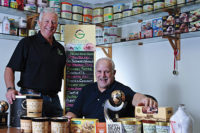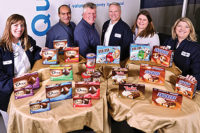The Gifford’s Ice Cream processing plant is tucked into a hillside on Hathaway Street in Skowhegan, Maine. This unassuming little band box of a building gives no hint that inside, production workers are creating super premium ice cream that is sold in company-owned and independently owned scoop shops and by retailers from Maine to Maryland.
The company’s tagline refers to its ice cream as “famous,” a bit of hyperbole created by the owners when they established the company in 1980. But there is no challenging the claim that the Gifford family makes a “world championship” product. They have the hardware to prove it. Gifford’s is the first ice cream maker to win the Grand Champion prize two years running in the Wisconsin Dairy Products Association contest. WDPA honored Gifford’s chocolate ice cream as the “best of the best” in 2010 and 2011.
Brothers Roger and John Gifford started the ice cream company, having bought the dairy business from their parents. Today, Lindsay Gifford Skilling, one of John’s daughters, runs the day-to-day operations and is the head of sales. (See related article on page 52.)
The brothers Gifford grew up in Connecticut where their parents owned a processing plant and operated a home delivery business. Their parents sold that business and bought the Hunt’s Dairy in Skowhegan in 1974. (The milk receiving station dates to the 1920s. Previous owners were Hoods, Whiting Milk and Skowhegan Jersey Ice Cream.) The Gifford family operated the plant as a full-line fluid operation until1983 when they sold the milk business to Oakhurst Dairy, Portland, Maine. Then, the Gifford sons converted the entire facility to an ice cream plant.
Gifford’s started with one employee and a 10-gallon batch freezer in a room measuring 12 feet by 30 feet. Roger and John Gifford used some of their family recipes dating back five generations. Later, the brothers moved into a 60-foot by 40-foot room where they operated one 80-gallon Cherry Burrell continuous freezer with two employees.
“We would make ice cream for eight hours filling bulk can and plastic half-gallons by hand and slide them through a small door into a 60- by 20-foot freezer,” Roger recalled. “After that we would go in the freezer and put away all the ice cream we made that day. It would take about two hours.”
The next upgrade was a 300-gallon continuous freezer and then a second one. Now the Giffords own three 400-gallon-per-hour continuous freezers. All are Silver Star Cherry Burrells.
“We believe these freezers make the best ice cream. They are dual-barrel continuous freezers which make a lot smoother ice cream,” says Roger, who earned a dairy science degree at the University of Tennessee. He and John learned all they could about dairy processing and ice cream making from C.E. “Doc” Lawrence, who educated generations of dairymen.
Other improvements to the Gifford’s Ice Cream plant included a tri-tray hardening system and more freezer storage space. In the early days, the ice cream would be static-hardened overnight. Ice crystals are the bane of ice cream, and processors do all they can to limit their size and formation. The tri-tray system minimizes freezing time and contributes to the ice cream’s smooth texture. Gifford’s employees installed the system themselves.







